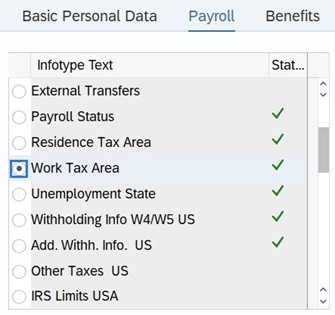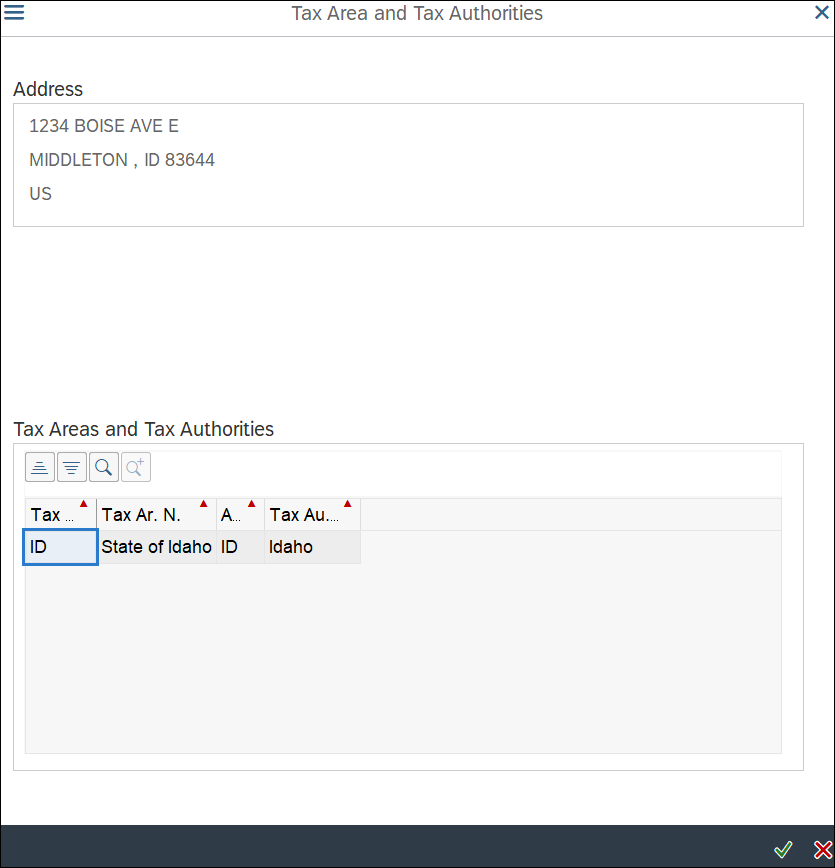Work Tax Area - Create New Record
Use this procedure to create a new Work Tax Area (0208) infotype record. Work tax area is used to identify the tax area and tax authorities that are applicable to the employee based on where they are working. Creating a new record is necessary when the employee does not have an active infotype record, or when the employee has an existing infotype record but you do not want to copy over the existing data fields.
The tax areas and tax authorities entered here help determine which tax types are assigned to an employee for some work location-based taxes. Refer to the Out-of-State Employee Coding Guide and HRMS Data Definitions Resource Guide for more information on which taxes are controlled by this infotype.
The Work Tax Area (0208) is used in combination with the Residence Tax Area (0207) and Unemployment State (0209) infotype records to determine all applicable tax types for the employee.
See Additional Steps for Out-of-State Employees for more information on setting up an out-of-state employee.
Before beginning this procedure, consider using the Out-of-State Tax Authority Locator report to verify the applicable work tax area(s) for the employee.
Before setting an employee’s work tax area to Oregon or Idaho, your agency must be configured in HRMS to collect Oregon or Idaho taxes. Agencies will not be able to save an Oregon or Idaho tax area unless they have completed the Additional Steps for Out-of-State Employees – Set Up Tax Company for OOS Tax Processing procedure first.
When updating a Tax Area or Allocation within the Work Tax Area (0208) infotype, combined allocation percentages cannot be greater than 100%. Avoid errors due to over-allocated percentages by using the Work Tax Area - Change Existing Record procedure to delimit any active records before attempting to create a new one.
A work tax area override can be entered in CATS. An override may be necessary when the employee works in a different tax area for a portion of a pay period and entering an allocation split on the employee’s Work Tax Area (0208) record is not desired. Refer to Additional Steps for Out-of-State Employees – CATS Work Tax Area Override user procedure for more information.
-
Step 1
Enter transaction code PA30 in the command field and click the Enter button.

-
Step 2
Complete the following field:
- Personnel no.

-
Step 3
Click Enter to populate the employee information.
-
Step 4
On the Payroll tab, select the Work Tax Area radio button.

-
Step 5
In the Time period section, select the Period radio button and enter the effective dates of the new record.
 TIPS:
TIPS:The From date should reflect the appointment’s effective date or the actual effective date of change.
The To date should reflect the end date of that tax area, or 12/31/9999 if no end date.
Unlike some other tax-related infotypes in HRMS, the work tax area is based on when wages are earned. It is not based on actual pay check dates.
HRMS will not retroactively collect taxes from an employee, but will refund an employee and correctly adjust the employer amounts (both collect or refund). Do not make retroactive changes across business areas or calendar years.
-
Step 6
Click the Create button.
-
Step 7
Select the appropriate Tax Area and Tax Authorities and click the Enter button.
 TIPS:
TIPS:HRMS automatically populates the Tax Area and Tax Authorities information based on the employee’s Out-of-State Work Location stored within the Addresses (0006) infotype. Processors should validate that the Work Tax Area address that appears in the Tax Areas and Tax Authorities pop-up screen matches the expected work site location.
If the address is incorrect, work with your personnel administration processor to update the Out-of-State Work Location address. Though the work tax area can be changed in Step 9, it is important that the employee’s Out-of-State Work Location address record is correct.
-
Step 8TIPS:
The Tax Area is populated from the Tax Area and Tax Authorities pop-up in the previous step. Processors may manually update the Tax Area field if the default value, based on the employee’s Out-of-State Work Location address, is not correct.
The Tax Area selected will populate the corresponding Tax Authorities. For example, selecting Tax Area OR01 will bring in OR and OR01 tax authorities.
Washington, Oregon, and Idaho are the only tax areas configured in HRMS.
- Use Oregon or Idaho work tax areas for employees working in Oregon or Idaho.
- Use Washington work tax area for employees living in Oregon or Idaho and working in Washington
- An active Work Tax Area (0208) infotype record is not needed for employees living and working in Washington or another state outside of Oregon or Idaho.
Refer to the HRMS Data Definitions Resource Guide for more information on tax areas, tax authorities, and tax types. For employees who work in Oregon, use Tax Area Codes OR, OR01, OR02, OR04, OR05, or OR06 only. Do not use Tax Area Codes OR03, OR07, OR30, and OR31, as they are not configured for use in HRMS.
If the employee is working in only one Tax Area, enter 100% in the Allocation field.
If the employee is working in more than one tax area, manually calculate the percentage worked in this tax area and enter the percentage into the Allocation field. Once you have created the initial record, use the Work Tax Area – Copy and Update Record user procedure to create additional records containing the other tax areas and allocation amounts. Ensure that the employee’s allocation equals 100% if there are multiple records.
Do not change the default value for the predominant tax area or enter data into the Source Tax Authority field. These fields are used for employees working in Pennsylvania and HRMS does not support automated tax collection for the state of Pennsylvania.
-
Step 9
Click the Enter button to validate the information.
-
Step 10
Click the Save button.
TIPS:Additional pop-up windows may appear depending on what data you entered. Validate each pop-up message to ensure the data you've entered is accurate. You may need to continue clicking the Enter and Save buttons, after validating each message, until the record saves.
When updating the employee’s Work Tax Area records, it is strongly recommended to check the employee’s other tax related infotype records to determine if updates are needed anywhere else as well. Refer to the Additional Steps for Out-of-State Employees – Set Up Out-of-State Employee and Additional Steps for Out-of-State Employees – End Out-of-State Employee user procedures if updates are needed.
If the employee is exempt from any of the tax types under the selected tax authorities, refer to the Other Taxes US user procedures to create or maintain exemptions.
Out-of-state Work Tax Area records must be delimited by the losing agency when an employee transfers to a new agency, when an employee separates, or when an employee stops working in Oregon or Idaho. Follow the Additional Steps for Out-of-State Employees – End Out of State Employee user procedure for more information.
The only exception is if the gaining agency has communicated to the losing agency that the employee will continue working out-of-state and the gaining agency is fully configured for the applicable OOS taxes and has requested the OOS tax infotype records remain active.

